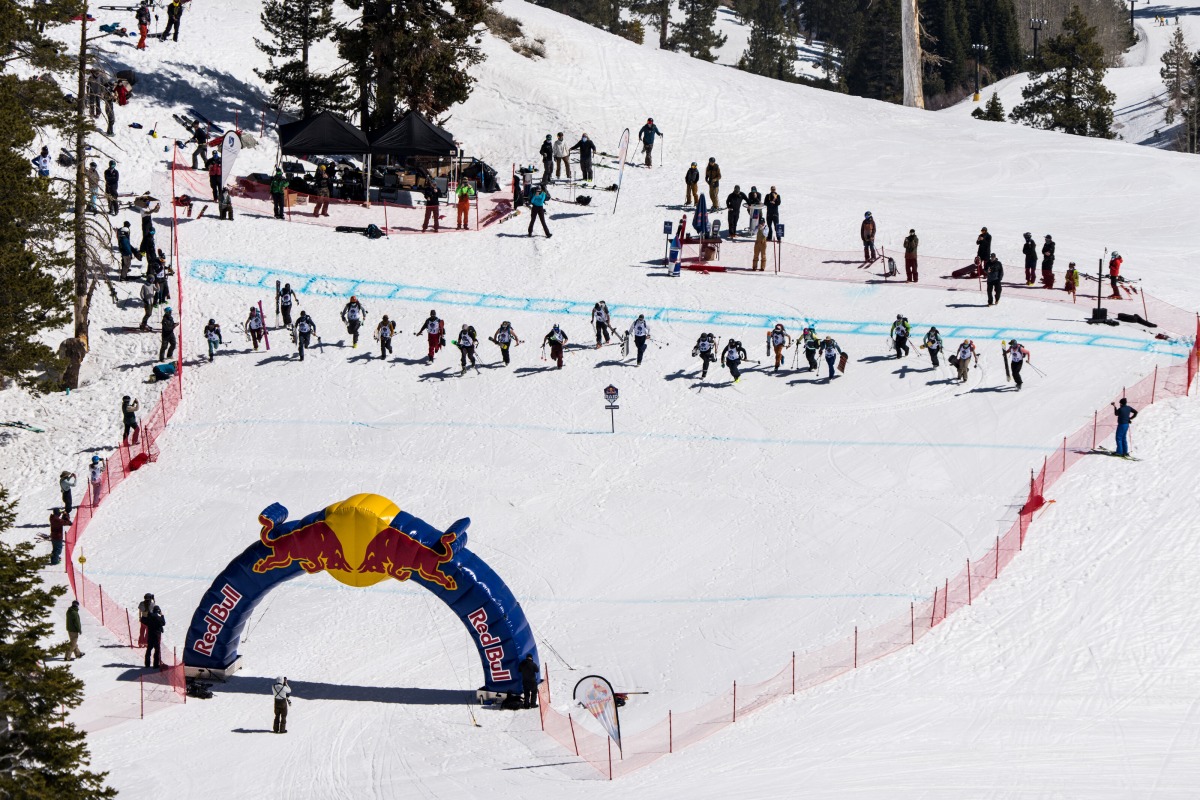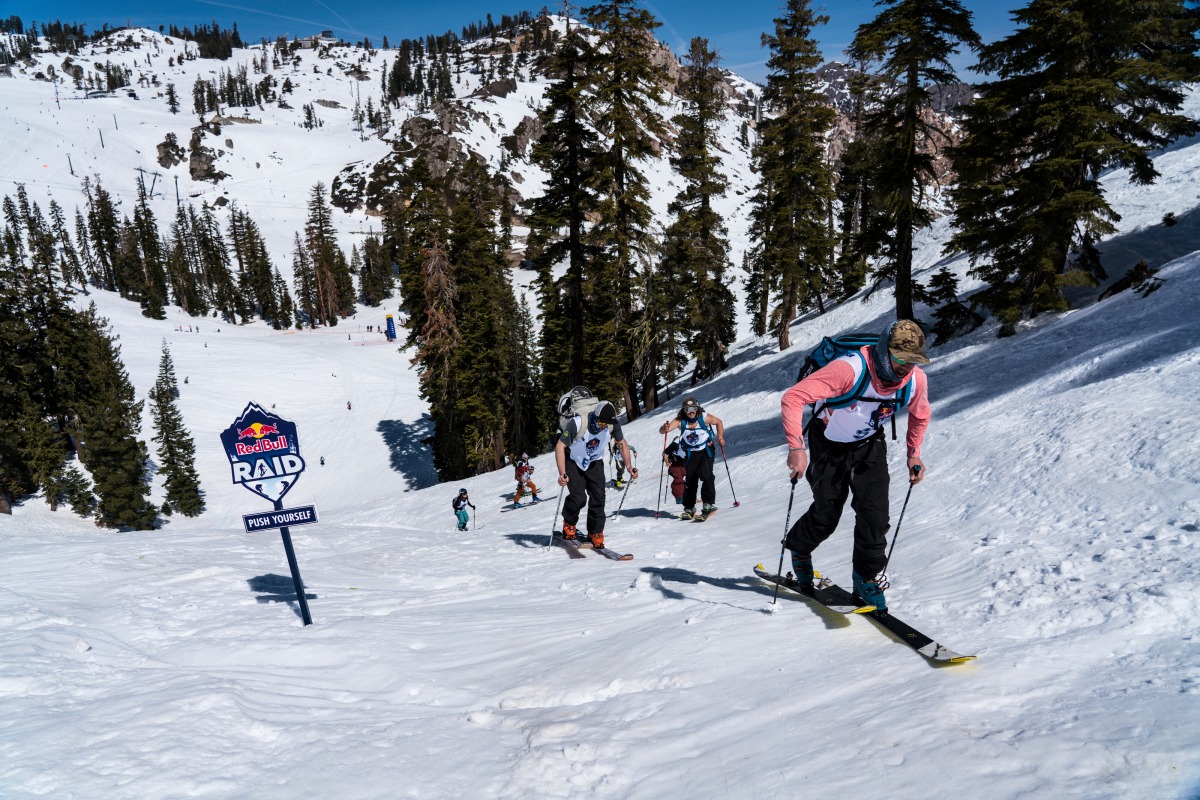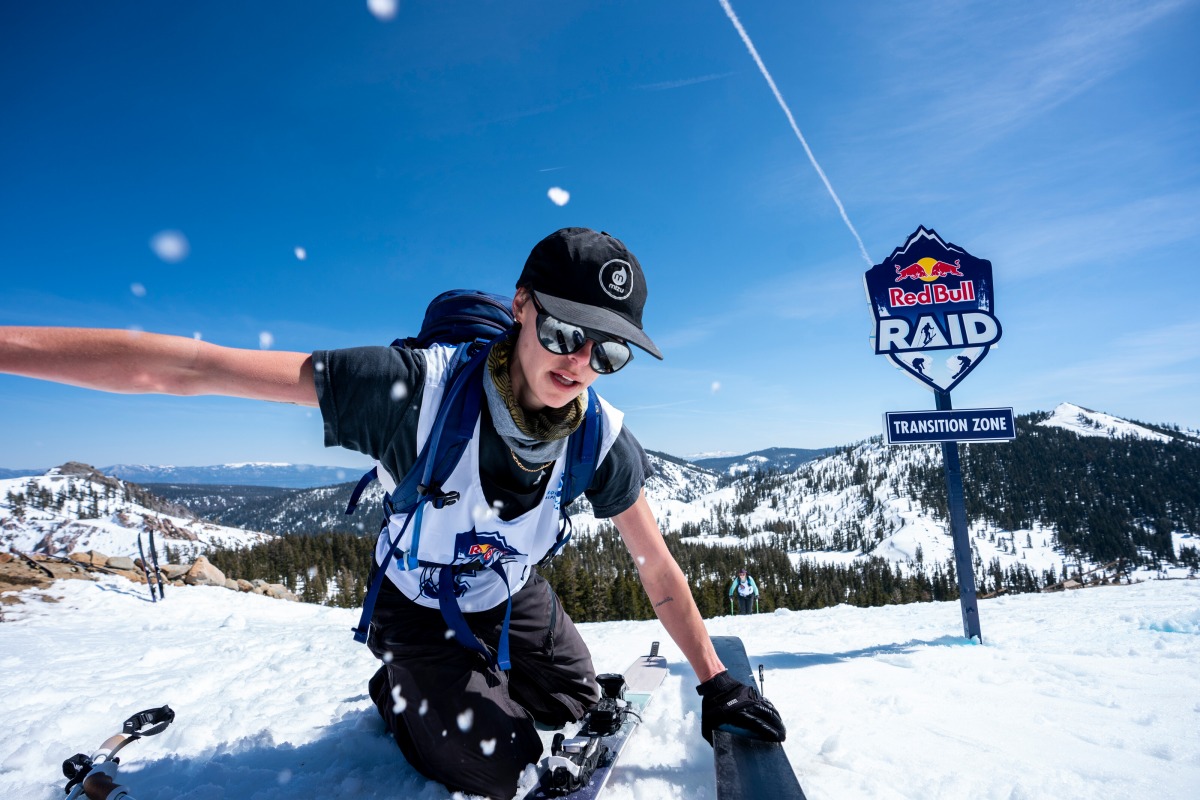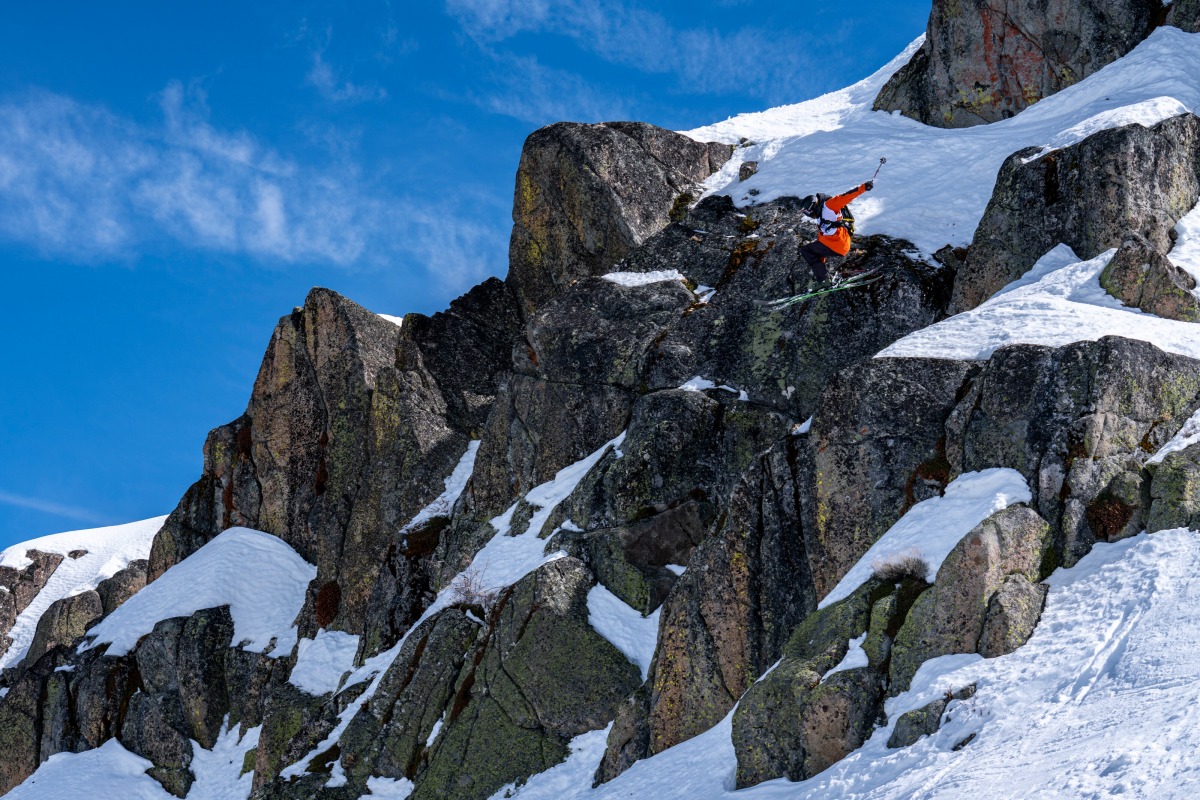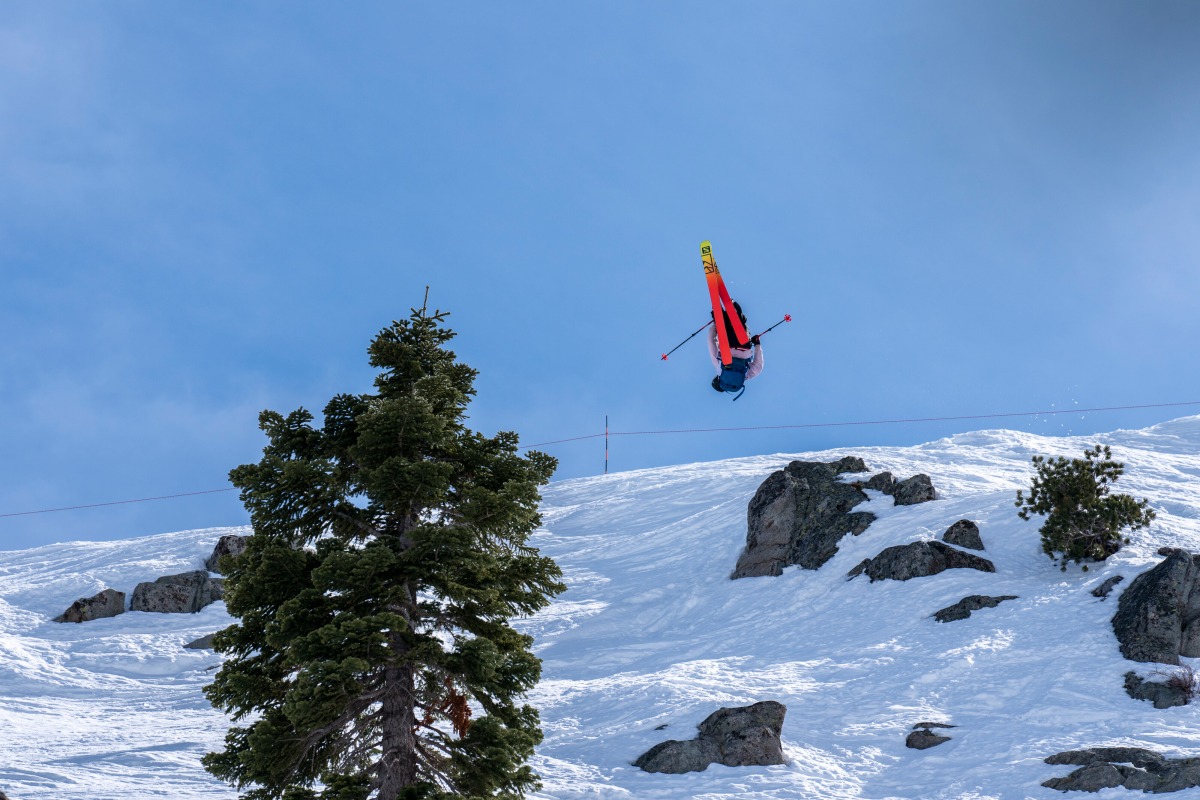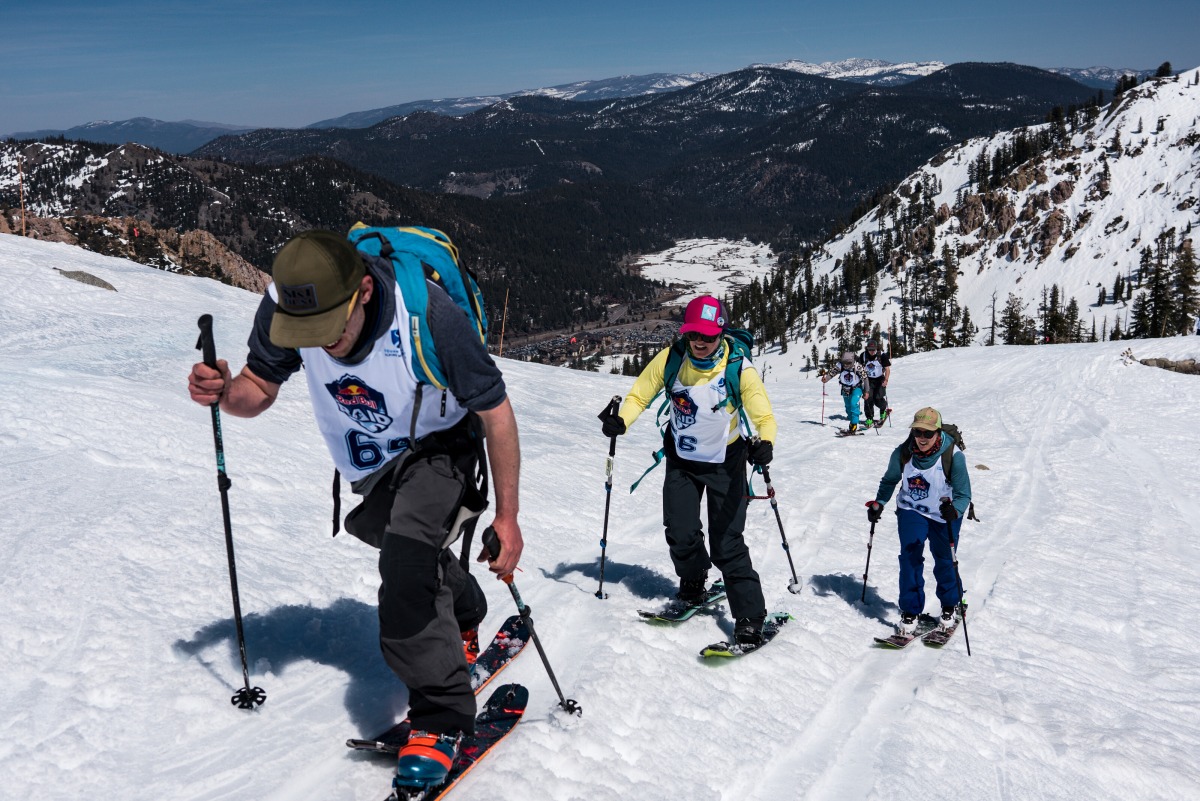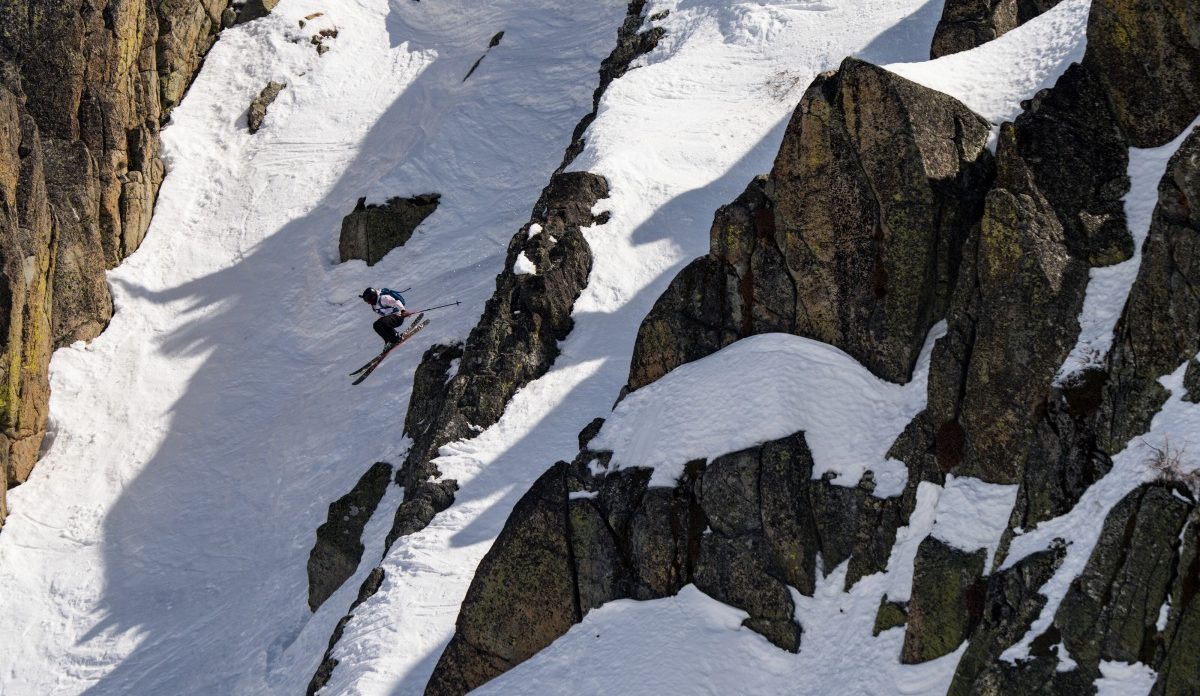
The Red Bull Raid combines uphill skinning fitness with technical freeride downhill skiing. Courtesy Red Bull Content Pool
Written by Roger Romani
As long as there’ve been those who love to ski tour for its own sake, there’ve been those who tour just to access downhill skiing. You’ve probably heard it a million times: “Oh, I’m more about the downhill than the up.” Recent advances in touring gear, as well as in how people use it, have created a new category somewhere in between, where skiers cover lots of vert while still aiming to rip it on the way down. To accompany this emerging class of skier, there’s a new term: “freemo”, a portmanteau of “freeskiing” and “skimo”.
Enter the Red Bull Raid, a new form of competition designed to put this class of athletes to the test. It combines essentially a skimo race, where competitors get points depending on how quickly they can get up to the top of a venue, and a freeskiing competition, where skiers and snowboarders ride a line with cliffs and natural features, being judged on what and how well they ride.
On the morning of April 2nd, I got the chance to compete in the second ever Red Bull Raid at Squaw Valley. Eighty skiers and splitboarders, including professional Red Bull athletes, ski town stars, and weekend warriors like yours truly lined up in the Cornice II bowl, an approximately 600 foot tall venue featuring a large cliff band as well as several bonus features above and below. To make the event slightly more manageable, we divided up into two heats of forty, with the top half of each heat proceeding to a combined finals.
The Up
The uphill began with a mass start, where competitors lined up with skis in hand, skins in bags and equipment in downhill mode. From the line, we sprinted the thirty feet to the transition zone, where we rushed to put down our skis and click in. I fumbled with putting my skins on, and made it out of the transition zone about tenth, striding out of the gate with the leaders already far ahead.
The uphill course started with a perhaps 25 degree ungroomed ski run, without a precut skin track. Competitors were free to pick their own skin tracks, and mostly chose to gun it straight up the hill with the help of their highest heel risers. By the time I was skinning, it was soft enough in most places to be fully manageable, but I (and others) still slipped out a few times on the icier sections, meaning that choosing our skinning line was a balance between a more direct line and a higher traction one. After the initial steeper pitch, the course rolled over onto a flatter ridge, where we were able to open the throttle a bit more as we raced to the transition area, about 600 feet above the start. After ripping skins (and stashing them away) we staggered through the finish gate where an official handed out cards denoting our order of finish.
With the top competitors completing the course and transitions in just under fourteen minutes, the skinning section of the event certainly qualified as a sprint. Transitions (especially the ski to skin transition) were important for getting a good result. I loved the head to head nature of the event, with the other competitors motivating me on the climb, as well as the relatively freeform course, which tested our ability to set a logical skintrack for ourselves.
The Down
After a fifteen minute or so cooldown period, we clicked back into our skis and lined up at the gate at the top of the course. The lines we had scoped from below (visual inspection only) were hidden below us beyond a roll in the terrain, and there was a nervous yet lighthearted energy in the start gate.
I called an audible, choosing the easier of the lines I had scoped, assuming that the judges would rather see fluid clean skiing then hesitant billygoating towards sloppy landings. My main feature, a eight foot or so mandatory air, went fairly well, and I managed to keep my speed under control under the runout. Unfortunately, I shed perhaps too much speed in the spring slop, and barely was going fast enough to pop off the lip of my bottom feature. As I jumped over the rolls leading to the finish corral, I could hear the other competitors cheering me on. It was great to feel the positive energy, which kept up throughout the entire event, growing especially pronounced for bigger stomps (and recoveries).
Conditions were fairly good, and other competitors were able to choose lines to fit their style and abilities. Some chose to ski fluidly down some of the more manageable chutes, while others hucked their meat. Finals saw a number of tricks, including a flat 3, a backflip, and 360s, as well as a massive gap and a number of 20+ foot cliffs. Watching others was at least half the fun, with the crowd hooting for their friends as they slashed around the venue, over rocks and off windlips.
The Gear
This event brought out the full gambit of ski gear, from the fairly light La Sportiva Skorpius CR, to full alpine boots with Daymakers. I personally brought out my daily driver touring setup, a pair of G3 SENDr 112s with Atomic Backland bindings, Technica Zero G boots, and Black Diamond mohair mix skins. While there was a smattering of CAST setups, frame bindings, and Alpine Trekkers, the majority of competitors seemed to have chosen a fairly standard weight setup: a wide and stiff but touring oriented ski, tech bindings, and freetouring boots. The narrowest waist I saw out there was probably a 95.
Splitboarders also competed, but I unfortunately am grossly unqualified to comment on their gear choices, other than everyone seemed to be in standard soft boot setups. Whatever they were using, it was working for them!
The Competitors
Most competitors were competing for their first (or one of their first) times, but especially in the Men’s Ski category, there were a good number of people with serious competitive freeride experience. These competitors especially tended to be on heavier gear, and to complete the climb slightly more slowly. To my knowledge, none of the competitors regularly participated in skimo races, but overall the field was an athletic bunch, with plenty of triathletes and ultrarunners (who tended to populate the faster end of the field).
With the exception of one competitor who unfortunately injured himself in his heat, no one seemed to be taking the competition too seriously. People were racing and trying to ski their best, but keeping it lighthearted and fun.
The Scoring
My biggest criticism of the event was in how it was scored. The score for each competitor was a combination of an uphill and downhill score, with one hundred points possible for each. In the uphill section, the first person in each division to reach the top got 100 points, the second 99, the third 98, and so on. The scores therefore ranged from 100 (the fastest) to 90. The downhill was based on your line choice, your style on that line, and your control.
The downhill scores seemed to have a much greater range than the uphill scores, with top runs (flips and spins combined with multiple big features) scoring in the 90s, average runs (technical lines without too much air and trickery) scoring in the 70s, and crashes and out of control runs scoring in the 30s-50s. Somewhat unfortunately, this resulted in a competition that seemed more like a freeride competition on touring gear with a slight speed based handicap than a true test of combined touring and freeride chops.
Ultimately, in the current format, the best freeriders won, whether or not they were the fastest uphill. Admittedly, this resulted in the most crowd pleasing runs winning, but it seems somewhat out of the spirit of the contest for the freeride element to be so heavily weighted.
Some suggested changes for future competitions:
-Separate the uphill finishers by three (or five) points, i.e. 100 for first, 97 for second, 94 for third…
-Let a forerunner in pure skimo gear set the pace, and then score based on the percentage of their pace, i.e. 100 for 100% of their pace or faster, 99 for 101% of their pace, 98 for 102%, etc.
-Simply rank the downhill finishers, and give 100 points to first, 99 to second, etc.
The Bottom Line
Red Bull Raid was awesome. I don’t like competitions, but had an excellent time, despite doing relatively poorly. It was such a positive, fun experience that I know I’ll be itching to sign up again next year. It also pushes the sport in what I see as a really positive direction, rewarding both athleticism and skiing chops, building more complete skiers.
There are rumblings about making this into a series, and I’m already wondering about whether I should drop my regular touring plans to try to be more competitive. Sure, I need to keep building my cardio up, but really, what I need is just a bit more time dialing in my flips and spins on touring gear…
Roger Romani is a skier based in the California Bay Area. When not skiing in Tahoe, the Eastern Sierra, or the Cascades, Roger can be found in a UC Berkeley Physics lab, where he works as a graduate student building dark matter detectors. You can follow him on Instagram @roger_romani.
Beyond our regular guest bloggers who have their own profiles, some of our one-timers end up being categorized under this generic profile. Once they do a few posts, we build a category. In any case, we sure appreciate ALL the WildSnow guest bloggers!

